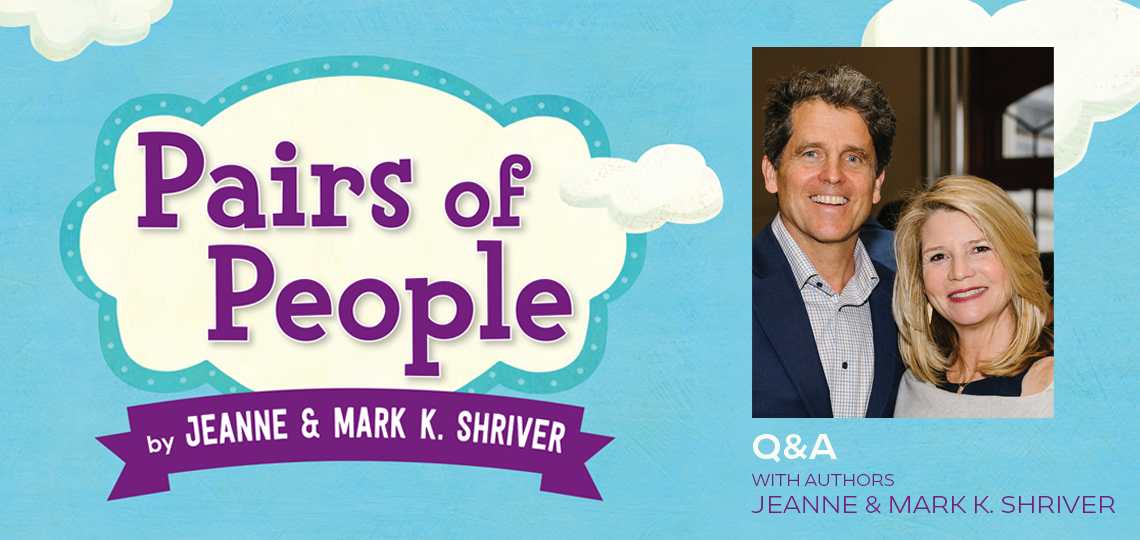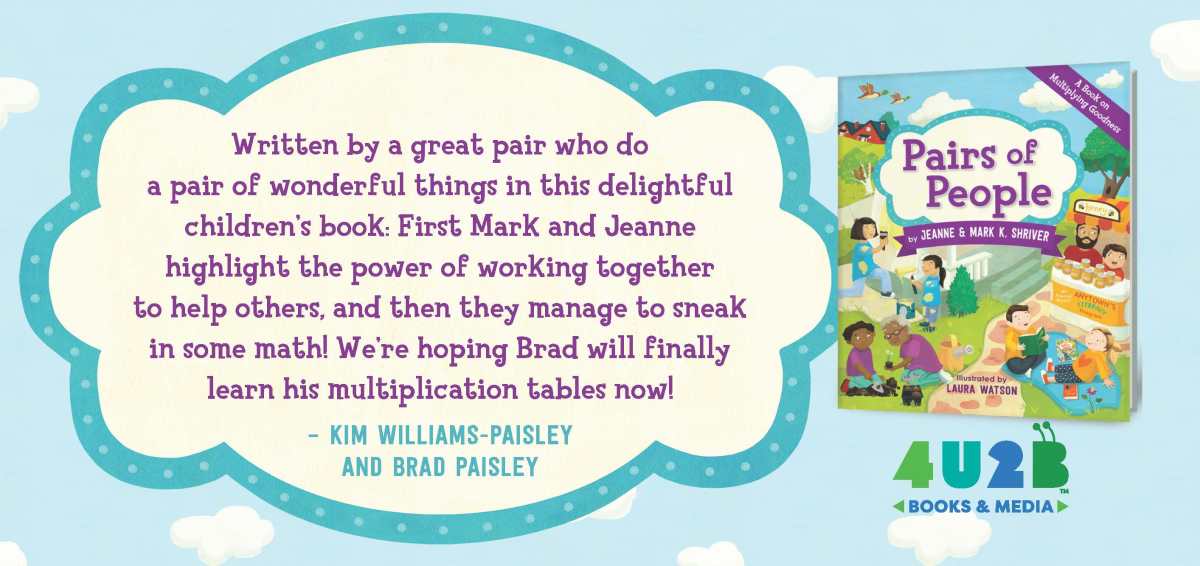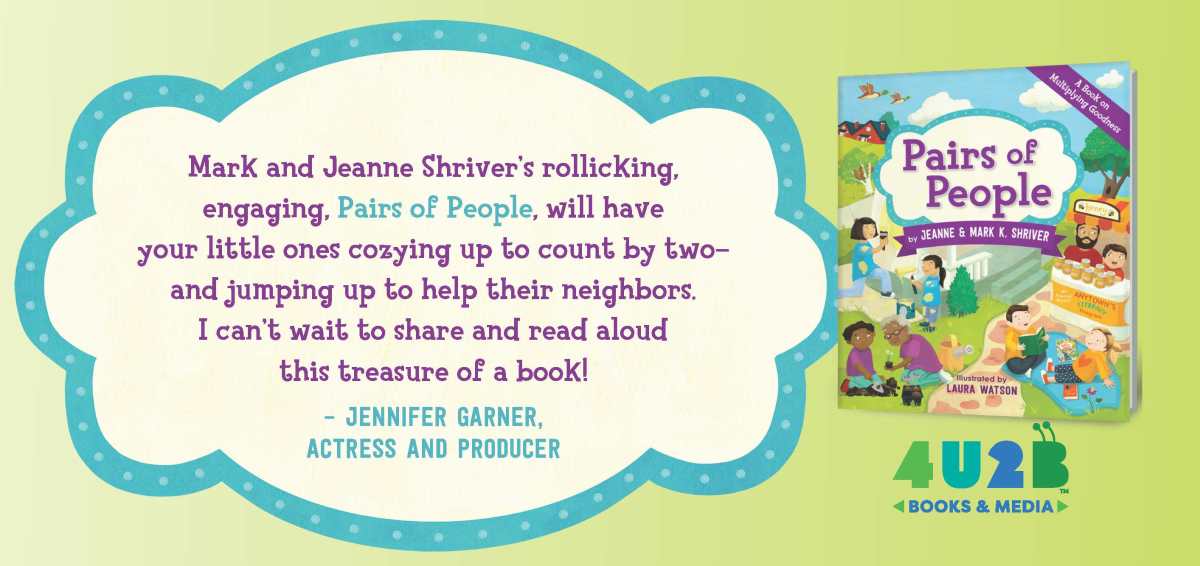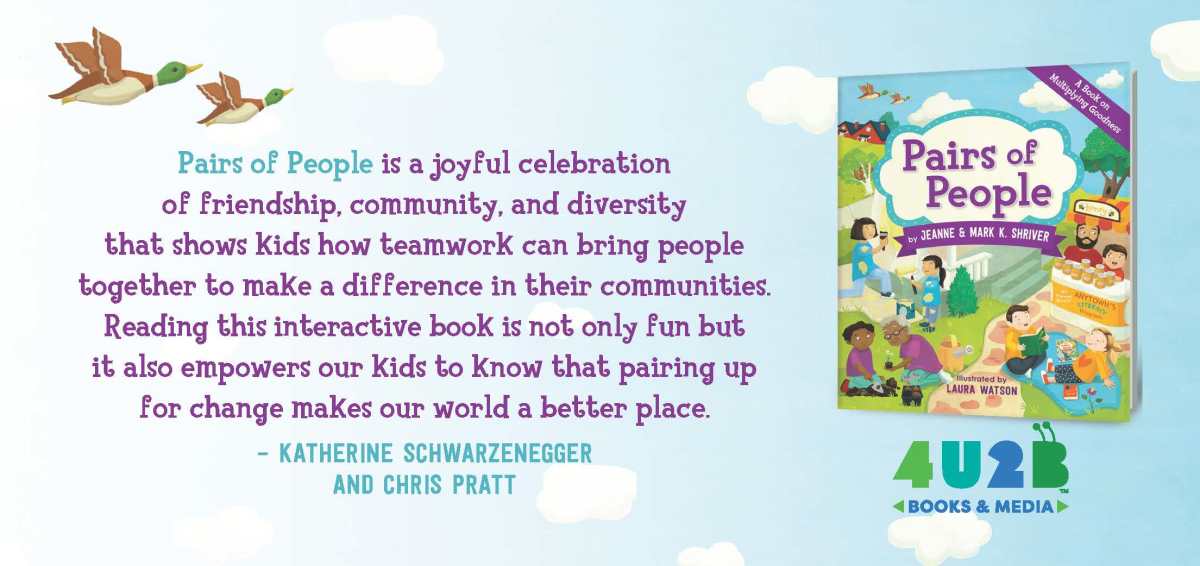Meet New York Times bestselling author Mark Shriver and his wife, Jeanne Shriver

Reviewer Kristine Morris Interviews Jeanne and Mark K. Shriver, Authors of Pairs of People
How to raise new generations of children enthusiastic about serving others—that is the question.
With rhyming text, expressive illustrations, and a joyful can-do attitude, Jeanne and Mark Shriver deliver a captivating answer in their new children’s book, Pairs of People. Clarion reviewer Kristine Morris calls it an “inspiring picture book that celebrates community spirit, friendship, and the joy of helping others. … Each lively stanza features a different helping activity: people clear a neighbor’s walk on a snowy day or work together to cook and serve food for those in need.”
To learn more about this very special project, we connected Kristine with the Shrivers for the following conversation.
Enjoy!
You’ve dedicated your children’s book, Pairs of People, to your parents, saying that they taught you “the power of working together in service to others.” How did they convey this important message to you, and what types of actions were you encouraged to take? What types of helping activities did each of you participate in as you were growing up?
Our parents led by example without ever calling it “service.” Mark’s father, Sargent Shriver, founded the Peace Corps, and his mother, Eunice Kennedy Shriver, founded Special Olympics International. Jeanne’s father was chief of pediatrics at Syosset Hospital in Syosset, Long Island. Jeanne’s mother volunteered at hospitals, the school for the deaf, and her church. So, we had larger-than-life examples of what it means to live lives in service to others.
We learned by watching them and grew up knowing it was not only important to help people, but that it could bring joy and purpose to our lives. From volunteering in soup kitchens to helping out at fundraising events, or volunteering at schools, these are the types of things we did in our childhood and still do today.
The story goes from one pair of people clearing snow from neighborhood walkways to raising funds for a prison literacy program, all the way up to eleven and twelve pairs engaging in disaster relief and providing food for the hungry. The book can be read and appreciated on several different levels: it teaches children math skills; it shows that when people of all ages, genders, and ethnicities come together to help each other, they can do a lot of good and have fun doing it; it gives examples of different kinds of community needs that people can help relieve; and it shows that when the number of people working together grows, the good that can be accomplished grows, too. What is there about this particular time in history that made you feel the need for a children’s book on this topic?
Children are “sponges” at such a young age, and they pick up so much. Right now, with everything going on in the world, we felt it was important to show them something positive and wholesome, and not only encourage but empower them to do what they naturally like to do, and that is help others. This type of participation can be an antidote to the division and negativity that is so prevalent right now. When you are working in a group to make a difference, to help people, you don’t have time to worry about differences, you just focus on community. That’s our hope for our children who will take over the world, that they be bold and empowered to go make a difference. And that’s what we try to show in Pairs of People.
The book encourages children to use their imagination and think big, asking “What if there were 50 pairs of people, working together as one? What positive difference could they make? What goodness could be done?” Please share some examples of people coming together to tackle the needs of their communities, especially service projects in which children have been involved, and how their help has made a difference.
Well, a great example of this is Special Olympics. Special Olympics is a massive global movement, so they depend on volunteers, and the difference they make is astounding. Teens can volunteer to help distribute t-shirts, help check athletes in, or anything else we can train them to do. They can volunteer for an afternoon, or it can turn into a lifelong passion, as it has for so many Special Olympics leaders.
Your book, with its lively rhyming text, Laura Watson’s bright and appealing illustrations, and its focus on math skills, friendship, and community involvement seems a perfect candidate for use in classroom or homeschool settings. Has the book been brought into such settings yet? If so, what has been the response of teachers and students? If not, what would it take to bring the book to the attention of schools or other educational venues?
We certainly hope that the book is finding its way into homeschools and classrooms! Sales of the book have been phenomenal—it was ranking very high on Amazon when it was released, so we know it’s getting a lot of attention. Plus, our appearance on Today with Hoda & Jenna and other news programs has gone a long way to getting the word out about the book.
With the prevalence of “screens” in daily life, entertainment, and education, what do you feel can be done to keep children engaged in reading books, and why is this so important?
Children are naturally curious and love to learn. We think when children have access to beautiful books with a fun message or story, they will take a break from the screens, slow down, and savor a quiet moment, especially when they have the attention of an adult. When we wrote Pairs of People, we intentionally wanted to make it an interactive experience in a way that is different from the interactivity of a digital game or device. An adult can sit with the child and make the book a fun seek-and-find activity, reading the words together then helping the child find the “pairs” in the pictures. Human interaction will always make this learning experience more impactful. As the child gets older, he or she can return to the pages again and again, using their imagination to explore the intricacies of the illustrations, as well as immerse themselves in the math prompts or the rhyming scheme. It is a book that they can grow with.
We should mention that Pairs of People is also available as an eBook. While this might seem counterintuitive, we wanted to make the book available in any format that parents and children prefer. Plus, the eBook is great for traveling, so children can take it with them anywhere!
With all the stories of disaster, war, and destruction that everyone is confronted with today, taking positive action can provide a sense of hope and agency, empowering even the youngest with the knowledge that they, too, can make a difference. Can you share the contact information of some community projects or organizations that welcome the participation of children?
As we mentioned, Special Olympics is a great volunteer opportunity for children to get involved. You can visit specialolympics.org to find your programs near you. Unified sports programs allow for children with and without intellectual disabilities to play sports together with an emphasis on inclusion, friendship, and understanding.
For other ideas, we recommend looking online for organizations close to home. Sites like volunteermatch.org are a great place to start and you can filter by opportunities that are great for kids. Animal shelters, libraries, and food banks are always looking for help, and most welcome children with their parents’ approval. You can also check out opportunities at your local place of worship.
What new projects do you have in the works?
We are currently working on another children’s book that will be released next year. This time it will be an alphabet book, but that’s all I can reveal right now! It will be published by 4U2B Books & Media, so stay tuned for the launch in 2023.
Please describe your writing process, and what it’s like for the two of you working together?
Even with a children’s book, the writing process breaks down into some pretty distinct steps: prewriting, first draft, revisions, and final editing. For Pairs of People, we knew we wanted to keep with a math theme, but next level from 10 Hidden Heroes, so multiplication just made sense. Plus, it worked with the idea of “multiplying goodness.” Collaborating on this book allowed us to each take a step back and work and rework the ideas until we both said “that’s it!” It was a fun, creative project to work on together and we couldn’t be happier with the results.
What did each of you most enjoy about writing this book, and about your collaboration?
Pairs of People is the follow-up to Mark’s first children’s book, 10 Hidden Heroes. In 10 Hidden Heroes, children learn to see heroes all around them, everyday heroes who help make their community a better place. Pairs of People takes that idea a step further—showing how working together to make positive changes makes us all “heroes.” Taking these concepts and bringing them to life in a way that children relate to was what was so rewarding about writing this book.
As for our collaboration, what we enjoyed most was putting out a book that is meaningful to us as a couple, and as a family. We wanted to share our vision for a world in which we can all come together in a peaceful, productive way to bring about change, starting with the people who are closest to us. It has been important in our own family life, and we wanted to share that vision with others.
Kristine Morris



